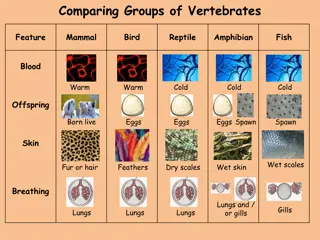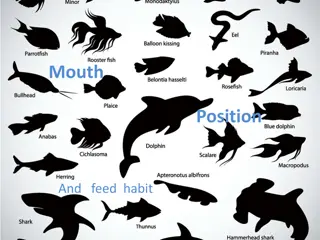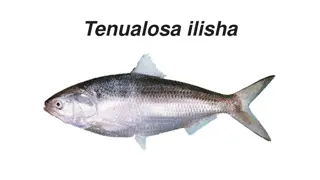The World of Fish: Aquatic Vertebrates and Their Diverse Characteristics
Fish, being cold-blooded aquatic vertebrates, thrive in various environments ranging from mountain streams to deep ocean depths. With around 2300 species, they showcase a wide array of traits such as unique reproductive strategies, sensory organs like the lateral line, and diverse classifications based on jaw structure. Understanding the primitive nature of fish and their role in aquatic ecosystems sheds light on their significance in the animal kingdom.
Download Presentation

Please find below an Image/Link to download the presentation.
The content on the website is provided AS IS for your information and personal use only. It may not be sold, licensed, or shared on other websites without obtaining consent from the author.If you encounter any issues during the download, it is possible that the publisher has removed the file from their server.
You are allowed to download the files provided on this website for personal or commercial use, subject to the condition that they are used lawfully. All files are the property of their respective owners.
The content on the website is provided AS IS for your information and personal use only. It may not be sold, licensed, or shared on other websites without obtaining consent from the author.
E N D
Presentation Transcript
FISH Fish are aquatic vertebrates that are cold-blooded, covered with scales, and equipped with two sets of paired fins and several unpaired fins. Fish are abundant in the sea and in fresh water, with species being known from mountain streams (e.g., char and gudgeon) as well as in the deepest depths of the ocean (e.g., gulpers and anglerfish).
Fish are the most primitive of vertebrates. There are about 2300 species of fish, which live in the fresh, salty or brackish water. Some species can live in all these types of water during the course of their life. Their bodies are covered with scales and they have fins to help their mobility. In most fish mobility is a result of waves contracting and then passing along the segmentally arranged muscle blocks on either side of the backbone. Fish breathe oxygen, which is obtained from the surrounding water. This is done by pushing water over gills, which are made up of a series of folded filaments with a large surface area. Fish are cold-blooded (known as exothermic), that is they are unable to maintain a body temperature different from that of their surroundings.
In fish, the lateral line is a sense organ used to detect movement and vibration in the surrounding water. Lateral lines are usually visible as faint lines running lengthwise down each side, from the vicinity of the gill covers to the base of the tail. Sometimes parts o the lateral organ are modified into electroreceptors, which are organs used to detect electrical impulses. It is possible that vertebrates such as sharks use the lateral organs to detect magnetic fields as well. The receptors in the lateral line are neuromasts, each of which is composed of a group of hair cells. The hair cells in the lateral line are similar to the hair cells inside the vertebrate inner ear.
CLASSIFICATION: There are about 28,100 species of fishes known to science, they are divided into 4 classes, 59 orders, 490 families and 4,300 or so genera. Classification of fish is based on Fishes of The World (3rd Edition) by Joseph S. Nelson 1994. Phylum Chordata Subphylum Vertebrata Supraclass Agnatha ( jawless fishes) Class Myxinoidea (hagfish) Class Petromyzontida (lampreys) Supraclass Gnathostomata (jawed fishes) Class Chondrichthyes- cartilagenous fish Subclass Elasmobranchii- Sharks, Skates and Rays Subclass Holocephali-Chimaeras or ratfishes Class Osteichthyes - higher bony fishes Subclass Actinopterygii ray-finned fishes Subclass Sarcopterygii lobe-finned fishes
Ray-Finned and Lobe-Finned Fish Ray-Finned Lobe-Finned Fish
REPRODUCTIVE STRATIGIES Fishes have a large range of sexuality (they stand out amongst vertebrates). Fishes may exhibit hermaphroditism, unisexuality (parthenogenesis), bisexuality (gonochorism), or a combination of sexualities. Fish Sexuality Gonochorism: Bisexuality Parthenogenesis: Unisexuality Hermaphroditism
1)Hermophroditsm: In synchronous or simultaneous hermaphroditism, the left gonad is the ovary and the right one is the testis or vice versa, or there may be an ovotestis. Although self-fertilization exists, it is rare. In asynchronous hermaphrodites,the fish start functionally as one sex and then switch to another. Protoandry-start as males and grow up as females Protogyny start as females and grow up as males. 2)Unisexuality or Parthenogenesis Rarer than hermaphroditism, but it is found in some live-bearers (only females). Development of young is without fertilization and females produce only female offspring. 3)Bisexuality:Gonochorism
REPRODUCTIVE PATTERNS Viviparous: Several groups of fishes have developed a live-bearing (i.e., giving birth to free-living larvae or juveniles, rather than laying eggs) life-history pattern. A prerequisite to this pattern is mating, copulation, and internal fertilization. Viviparous fishes have internal fertilization and are characterized by the embryo developing in close contact with the nourishing maternal tissue. Oviparous:Eggs of the vast majority of fish, especially marine fishes, are released before fertilization these are the oviparous fishes (literally, egg- laying fishes). Males and females swim close together so that the eggs are shed into a cloud of spermatozoa. Ovoviviparous fish keep the eggs inside of the mothers body after internal fertilization. Each embryo develops in its own egg. The young are 'born alive' like most mammals.
A.Agnatha:Jawless fish These are primitive eel-like fish whch have cylindrical bodies up to a meter long supported by a cartilaginous skeleton.Their smooth skin lacks scales, and they have no paired fins. Most hagfish eat worms and other nvertebrates.They do not have a true jaw, but a sucker-like mouth and rasping teeth. There are two main types: A.Lampreys Lampreys are found in freshwater lakes and streams as well as in salt water. Adult lampreys swim upstream to lay eggs in the gravel beds of streams. one or two dorsal fins are present eyes well developed sucking mouth; barbels absent; sexes separate parasitic (freshwater or anadromous) or non-parasitic (only freshwater)
B. Hagfish Hagfish, or blind eels, are found only in salt water and feed mainly on dead fish. eyes are degenerate, lens absent barbels present around biting mouth the dorsal fin is absent; the caudal fin extends onto part of the dorsal surface numerous mucus pores along body expel a slimy substance (hence nickname slime eels ), for feeding and defense. ovaries and testes in same individual, but only one functional at a time or season (not hermaphrodite)
Image:Havsnejonga.jpg Image:Eptatretus stoutii heads.jpg HAGFISH HAGFISH SEA LAMPREY SEA LAMPREY
THE BONY AND CARTILAGINOUS FISHES ARE COMMON IN MOST AQUATIC HABITATS. Bony Cartilaginous mostly cartilage small, tooth like scales (denticles) mostly saltwater open to outside Features Skeleton Skin bone, cartilage flat scales (eels lack scales) salt, fresh, brackish covered by flap (operculum) mobile present (except in bottom dwelling forms) can rise and sink in same position external fertilization Habitat Gills Fins Swim bladder limited movement absent (large liver provides buoyancy) must keep moving to avoid sinking internal fertilization Movement Reproduction
B.Cartilaginous fish Cartilaginous include the sharks, skates and rays. Although these look different, they have many features in common. None of them have any true bone , their skeleton is made of cartilage. They have strong jaws and their mouth is on the underside of the body, and their eyes are on top. They cannot see food as it enters their mouth. Some sharks solve this problem by touching their food briefly with their nose first. Some also use a powerful electrosensory system.
Presence of five to seven gill slits. shark skin made up of denticles (placoid scales) for protection lack swim bladder, so need to keep swimming to avoid sinking. most are predatory, but some are filter feeders of plankton large olfactory bulb for excellent smelling efficient intestine with spiral structure internal fertilization most bear live young replaceable teeth in multiple rows along edges of upper and lower jaws, placoid scales
C.Bony fish Bony fish are often regarded as "true" fish. They have a bony skeleton and a single pair of external gill openings covered by a gill cover/operculum. The mouth is generally at the front of the body and they have a tail fin, with the top and bottom portions nearly the same size. Presence of swim bladder for buoyancy. Internally, the intestine of the bony fish is a relatively short tube. Bony fish reproduce by external fertilisation of eggs. The female generally produces a large numbers of eggs and releases them into the water. The male releases sperm, normally called milt, into the water. The milt fertilises the eggs.
FISH HABITATS: The reason some fish normally live in freshwater and others live in seawater is that one or the other environment provides them with opportunities that contribute to their survival. An obvious difference between the two habitats is salt concentration. Freshwater fish maintain the physiological mechanisms that permit them to concentrate salts within their bodies in a salt-deficient environment; Marine fish, on the other hand, excrete excess salts in a hypertonic environment. Fish that live in both environments(MIGRATORY) retain both mechanisms.
Freshwater Marine
Migratory fish are classified according to the following scheme: 1.diadromous fish travel between salt and fresh water. There are three types of diadromous fish: anadromous fish live in the sea mostly, breed in fresh water (Greek: 'Ana' is up; The noun is "anadromy") e.g SALMONIDS catadromous fish live in fresh water, breed in the sea (Greek: 'Cata' is down) e.g. EELS amphidromous fish move between fresh and salt water during some part of life cycle, but not for breeding (Greek: 'Amphi' is both) 2.potamodromous fish migrate within fresh water only. (Greek: 'Potamos' is river) 3.oceanodromous fish migrate within salt water only. (Greek: 'Oceanos' is ocean)
Fresh water fish are fishes living the whole or parts of their lifes in fresh water, such as rivers and lakes with a salinity on less than 0,05 %. 41 % of all known species of fish are found in fresh water. Fresh water fish differ physiologically from salt water fish in several aspects. Carps are common fresh water fish all over the world. To survive fresh water, the fish needs a range of physiological adaptations in order to keep the ion concentration of the body balanced. Their gills must be able to diffuse water while simultaneously keeping the salts of the bodily fluids inside. The scales of the fish also plays a part in the process; fresh water fish that have lost too many scales get a surplus of water diffused in through the skin, causing the fish to die. Another trait characteristic of fresh water fish are the well developed kidneys. These have to be large because a lot of water passes through them.
Image:Common carp.jpg Common carp- Cyprinus carpio
CARPS CARPS Carp is a common name for various freshwater fish of the family Cyprinidae, a very large group of fishes originally from Eurasia and southeast Asia. Carp usually refers only to several larger cyprinid species such as Cyprinus carpio (common carp), Carassius carassius (Crucian carp), Carp have long been an important food fish to humans, as well as popular ornamental fishes .
TILAPIA : Tilapia is a large genus in the cichlid family (Cichlidae). The genus Tilapia, as well as closely related genera like Oreochromis and Sarotherodon. Tilapia is a popular food fish and many species can easily be cultivated in ponds. It has been an important source of protein Africa ,for thousands of years and the Ancient Egyptians cultivated tilapia in ponds along the Nile. Today, tilapia is a popular food fish all over the world and it is also kept in aquariums.When it comes to tilapia farming, species such as Nile tilapia (Oreochromis niloticus) and Mozambique tilapia (Oreochromis mossambicus) are appreciated since they grow fast and refrain from breeding until they are comparatively old. Oviparous ,substrate or mouth brooders.
MARINE FISH A. Sharks Belong to the class Chondrichthyes have to keep swimming, otherwise they will sink to the bottom of the ocean. This characteristic has led to two distinct forms of sharks: the pelagic and benthic forms. The pelagic sharks move constantly through the water and rely on this movement to pass water across the gills for respiration. The benthic forms lie on the bottom and take in water through a pair of holes at the top of their head called spiracles. Sharks are a type of fish with a full ca rtilaginous skeleton and a streamlined body. They respire with the use of five to seven gill slits. Sharks have a covering of dermal denticles to protect their skin from damage and parasites and to improve fluid dynamics; they also have replaceable teeth. Shark gill slits are not covered like other fish, but are in a row behind its head.
Unlike bony fish, sharks do not have gas-filled swim bladders for buoyancy. Instead, sharks rely on a large liver, filled with oil that contains squalene. The buoyant liver may constitute up to 30% of their body mass. Its effectiveness is limited, so sharks employ dynamic lift to maintain depth and sink when they stop swimming. Osmoregulation In contrast to bony fish, the blood and other tissue of sharks and Chondrichthyes in general is isotonic to their marine environments because of the high concentration of urea and trimethylamine N-oxide (TMAO), allowing them to be in osmotic balance with the seawater. This adaptation prevents most sharks from surviving in fresh water, and they are therefore confined to a marine environment.
SKATES AND RAYS Batoidea is a superorder of cartilaginous fish containing more than 500 described species in thirteen families. Batoids include stingrays, skates, electric rays, guitarfishes and sawfishes. Batoids are flat-bodied, and, like sharks, are a species of cartilaginous marine fish, meaning they have a boneless skeleton made of a tough, elastic substance. Most batoids have 5 ventral slit-like body openings called gill slits that lead from the gills. Batoid gill slits lie under the pectoral fins on the underside, whereas a shark's are on the sides of the head. Most batoids have a flat, disk-like body, with the exception of the guitarfishes and sawfishes, while most sharks have a streamlined body. Many species of batoid have developed their pectoral fins into broad flat wing-like appendages. The anal fin is absent.
The eyes and spiracles are located on top of the head. Bottom-dwelling batoids breathe by taking water in through the spiracles, rather than through the mouth as most fishes do, and passing it outward through the gills.
What are the differences between rays (left) and skates (right)? The major difference between rays and skates is in their reproductive strategies. Rays are live bearing (viviparous) while skates are egg laying (oviparous). Also, skates typically have a prominent dorsal fin while the dorsal fin is absent or greatly reduced in rays.
Most rays are kite-shaped with whip-like tails possessing one or two stinging spines while skates have fleshier tails and lack spines. Rays protect themselves with these stinging spines or barbs while skates rely on thorny projections on their backs and tails to for protection from predators. Another difference is that rays are generally much larger than skates. SKATE SKATE RAY RAY























